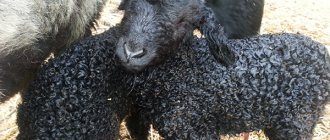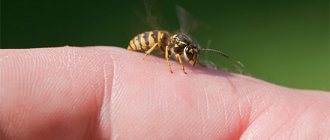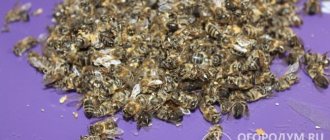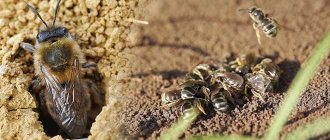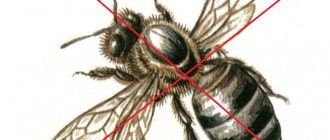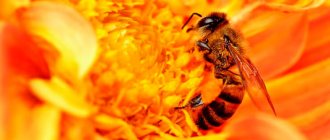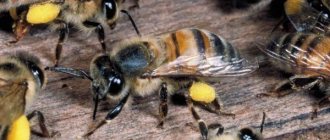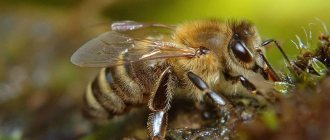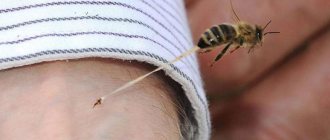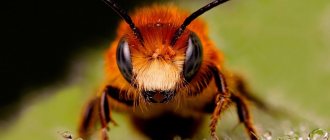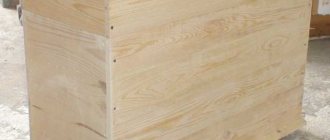Almost every person who has thought about the life of bees in one way or another wants to know where a bee gets its wax. Indeed, this is an interesting question, because wax by its nature is a unique substance and cannot be found almost anywhere. Before you find out where bees get wax to build honeycombs, you should turn to biology and learn about the structure of the body of bees. Today we will talk about the construction of wax honeycombs by bees. Read the following article on the pages of the magazine and you will find out where bees get wax for their honeycombs.
What does a bee's honeycomb look like?
The question of what honeycombs look like has long been of interest to humanity, in particular to biologists, mathematicians, physicists and simply curious people.
Honeycombs consist of many cells, each of which is 6-gonal in shape with smooth edges.
Scientists have identified 2 reasons for this:
- The hexagonal structure allows cells to be placed to minimize their overall perimeter and optimize the consumption of building materials.
- This form is the most durable.
Cell material
To build cells, insects independently produce special wax. There is simply no more suitable material for these purposes, because beeswax has the following properties:
- it is so soft that it is easy to give it the desired shape;
- after hardening, it acquires strength and retains its outline well;
- is durable;
- resistant to oxygen;
- has an antimicrobial effect, preventing the proliferation of harmful bacteria.
No building material created by human hands has such a set of characteristics!
Types of honeycombs
There are different types of cells: bee, drone, transitional, queen cells.
Bees
Such honeycombs are designed for breeding worker bees and storing honey and bee bread. They are characterized by high strength, although they are made of plastic wax.
To build 1 cell, an insect spends about 13 mg of wax. The horizontal diameter of the new structures is from 5.3 to 5.7 mm, the depth is from 10 to 12 mm. Over time, their volume decreases, because Insect larvae shed their cocoon several times, which sticks to the walls. As the internal free space decreases, smaller individuals appear in the combs, which becomes obvious already in the 3rd generation.
6 days after the larvae emerge, the bees seal the cells with lids made from a mixture of wax and pollen.
Such superstructures have a porous structure that prevents the movement of air flows in the internal cavities.
Drones
These cells are designed for breeding males and storing honey reserves.
The average diameter of newly built cells reaches 7 mm, and the depth is 14.5 mm. Their production requires 2.3 times more wax. Bees also seal them with lids, which have a loose texture and consist of glued grains of wax.
Transitional
These elements are located between the bee and drone cells. They provide a smooth transition between ridges. The cells of such honeycombs can look different: they are generally irregular in shape and include 4–10 corners. This allows you to change the spatial orientation of subsequent ridges.
Queen cells
There are a small number of enlarged cells designed for breeding queens. After the birth of the oviparous female, insects destroy such structures.
Performance
The productivity of a bee colony depends on many factors, so any estimate will be approximate. A standard hive frame measuring 43.5 by 30 cm can accommodate about 8,000 bee cells on both sides. Considering the average cell volume (0.28 cm3), you can get a little more than two liters of honey from the frame.
For good profitability of the apiary, the beekeeper should control the number of frames installed - there should always be enough of them to expand the nest with bees. Lack of space leads to delayed laying of eggs by the queen and a decrease in the number of worker bees. During honey collection, free areas are also needed to place the extracted nectar, otherwise insects may remain inactive or begin to swarm.
The structure of a honeycomb
In modern hives, the honeycomb structures are placed on frames, which are then installed parallel to each other in the interior of the hive.
Framework
The honey frame is the main structural element of the hive. It is the foundation for building up the honeycomb. It can be easily taken out to check bees for pathologies or extract honey.
Honeycomb
This is a massive structure formed by hexagonal prismatic cells located on both sides of the hive frames. It is convenient to view them on a flat surface.
Types of beekeeping: log beekeeping, beekeeping and frame beekeeping:
There are log beekeeping, board beekeeping or beekeeping (from the word “bort” - tree hollow) and frame beekeeping.
In log beekeeping, bees are kept in non-dismountable hives made of wood (logs, nest boxes), clay and other materials.
In airborne beekeeping, bees live in tree hollows. Hollows can be natural or several hollows hollowed out in thick trees at a height of 4 to 15 m. Hollows can also be hollowed out in logs, which are then hung on tree trunks. Nowadays, beekeeping is practiced in Bashkortostan.
In frame beekeeping, bee colonies are raised in collapsible hives with removable frames on which honeycombs are built. The basis for the new honeycomb is waxed on the frame - a thin sheet of beeswax with bottoms and the beginnings of cells pressed out on both sides. Starting to work on a new wax, the bees first pull out the beginnings of the cells, and then build them up by adding wax secreted by themselves. The result is a double-sided honeycomb with regular rows of bee cells.
A frame hive kit usually includes the following parts:
– removable bottom (in a number of designs the bottom is part of the 1st body);
– housings (depending on the type of hive from one to several);
– store extensions (there can be one or several, often regardless of the type of hive); each extension has one complete set of frames (depending on the design 10-24);
– roof (if bees are kept in a pavilion, there may be no bees, because the hives are located under the roof of the building/trailer);
– frames in which bees build honeycombs; As a rule, two sets of frames are held for each body, and one for the extension;
– frame dividers (for example, pegs or another system for fixing a certain width of the inter-frame space);
– a canvas or ceiling made of a thin board (it is laid on top of the frames of the uppermost body);
– a feeder (most often it is a frame feeder);
– arrival board? most often it is non-removable and is located under each entrance;
– diaphragm (to separate families sharing one building; or the inhabited part of the building from the empty one);
– one or more separating grids (they do not allow the queen to penetrate into the housing or honey stand and sow eggs there);
– a pillow or several (filled with dried moss, cotton wool or other material).
Composition of honeycomb
The main component of honeycombs is beeswax, secreted by special glands on the abdomen of working insects. It is stable and waterproof, which is why it is used to rebuild the cell frame. The chemical profile of the wax includes approximately 71% esters, 15% hydrocarbons, 6% fatty acids.
The cellular cavities are filled with honey, about 97% of the mass of which is an aqueous solution of sugars. The remainder includes a small amount of proteins, vitamins, minerals, and bioactive compounds.
Where does a bee get wax from: wax glands
The bee has special wax glands, which produce a whitish-yellow viscous substance. This is done by working females starting at the age of 15-18 days. Wax appears on their bellies in the form of whitish plates. It is curious that there is no loss of wax during its production, and all types of bees produce it. Most of it is obtained from young individuals.
Wax is produced by the uterus. This is a special substance that is produced by special glands located on the abdomen of the insect. The bee begins to produce wax at the age of 12-18 days , with younger individuals producing more wax. The insect accumulates nectar, which is then filtered in the oral apparatus. The purified nectar is sent to the address cell, and the filtration product (pollen particles) is used as raw material for the production of wax. In production, only the pollen that enters the body directly with the nectar is used. The wax has a unique composition that is almost impossible to replicate under artificial conditions.
The process of constructing a honeycomb
First, worker bees prepare the hive space by covering its walls with a thin layer of sticky propolis. This substance consists of plant resins and wax. Insects use it at various stages of construction to cover cracks and holes.
With the help of their mandibles, bees crush the wax they secrete into small balls, which are placed from top to bottom in a checkerboard pattern. Under the influence of the heat generated by insects during work, the wax granules melt. Gradually they become flat and take on the shape of a regular hexagon. Bees make internal cavities in the granules, carefully controlling the depth of the cells and the width of the walls.
Cellular walls are highly durable and can withstand 30 times their own weight. Honey is stored in the cavities of the upper cells, pollen is stored in the lower cells. Behind them are brood combs.
Storage
Beeswax
Considering the great benefits of honeycombs, it is important to be able to preserve their qualities for as long as possible at home. Propolis in comb honey acts as an excellent natural preservative.
Increased resistance to most microorganisms gives the honeycombs a fairly long shelf life.
Among the threats to bee honeycombs removed from the hive, it is worth highlighting the main ones. These include:
- Moisture. When the permissible humidity limits are exceeded, the honey in the combs begins to deteriorate. Therefore, the humidity in the honey storage room should not exceed 60%, and it is also necessary to ensure sufficient ventilation.
- Sun. Exposure to direct sunlight and high temperatures accelerates the destruction of honey in honeycombs. So honey needs to be removed from the sun and heat.
- Insects. The most common pest here is the wax moth. She is especially active in the hot season. Well-ventilated rooms with an air temperature no higher than 10°C protect honey in combs from such insects.
- Mold. It develops when the humidity is too low, and it is quite difficult to get rid of it, so you should not allow it to appear.
After considering the dangers that threaten honey in a honeycomb, protecting it from them will not be difficult. The optimal storage conditions for honeycombs are a suitable temperature - from 3 to 10°C.
Also, when storing honey, you should know that it absorbs foreign odors well, so you need to keep it separate from strong-smelling products.
Storage containers should always be covered with a lid. Honey in honeycombs, if all conditions are met, can be stored in a liquid state for up to 3 years.
Is it possible to eat honeycombs?
The entire honeycomb, including the raw honey and wax base, can be eaten. However, before use, you should consult your doctor, because... the product contains potential allergens.
Contraindications for use
Natural honeycomb is considered a safe product, but raw honey may contain the spore-forming bacteria Clostridium botulinum. These microorganisms produce neurotoxins that are especially dangerous for pregnant women and young children.
The product should not be used by patients with gastrointestinal pathologies and intolerance to the chemical components of raw honey. Healthy people are not recommended to eat large quantities of the product to avoid digestive upset.
Honey gum
When the honey ripens, the bees seal the cells with lids made from a mixture of pollen, propolis, and wax. Such superstructures are called zabrus, or honey chewing gum.
Bee baling is useful for the following conditions:
- development of inflammatory processes;
- pathologies of the musculoskeletal system;
- diseases of the oral cavity;
- reactive and chronic diseases of the nasopharynx;
- acne.
Honey gum has a sedative effect, helping a person cope with stress and reduce the symptoms of neuropsychiatric diseases.
Contraindications
The benefits and harms of cells with sealed nectar have long been studied. This API product contains a number of components that can cause allergies. A similar reaction is expressed in a rash. In addition, a person may experience nausea and an unpleasant aftertaste, which cannot be relieved even by drinking plenty of water. A similar reaction occurs due to excessive consumption of the product.
In addition, bee nectar in honeycombs should not be consumed:
- persons suffering from diabetes;
- children under 3 years old;
- chronic pancreatitis;
- pathologies of the kidneys and liver.
Expectant and nursing mothers should use bee products with caution. If possible, you should completely eliminate nectar from your diet. Because it can provoke allergies in mother and child.
How to get honey from honeycombs?
To extract honey, beekeepers often use a honey extractor, the basic element of which is a centrifuge. The honeycomb is unsealed and placed in a device that, when turned on, begins to rotate rapidly. Under the influence of centrifugal forces, liquid honey gradually flows out of the cells and is collected in a special tank.
Many beekeepers believe that obtaining honey without centrifugation is unprofitable.
However, it can be done like this:
- Carefully cut the honeycombs from the frame, break them into small pieces and place them in a bucket.
- Grind the product using a wooden masher.
- Strain the resulting mixture through cheesecloth.
This process takes a lot of time. To reduce the number of manipulations, you can simply cut the cellular structure with hot scissors and let the honey drain naturally into the container.
Honeycomb wax quality
To provide apiaries with high-quality honeycombs, beekeepers annually discard 30% of old, blackened or incorrectly built honeycombs and replace them with new ones built on artificial foundation. Thus, every three years the nest frame is completely renewed.
Currently, on state and collective farm apiaries, building frames are used to obtain wax. This wax, called Kapanets wax, is of high quality. Building frames during the main bribe can be used to obtain sectional honey.
High-quality wax is obtained from caps - wax caps, cut off when unsealing honeycombs during honey pumping.
A certain amount of wax can also be obtained by cleaning frames during the inspection of bee colonies and in the process of work throughout the season. Using the above methods, beekeepers in the Far East receive 2-3 kg of wax from each bee colony per season.
Obtaining wax from hives is a labor-intensive process and involves melting down the honeycombs and straining the resulting substance until all dirt is removed and it acquires a uniform color. After this, the liquid wax is poured into molds, where it hardens and becomes suitable for use.
Sources
https://nolvoprosov.ru/animals-plants/335765
https://paseka.pp.ru/spravochnaya-kniga-pchelovoda-pelmenev-vk/728-poluchenie-voska-ot-pchel.html
https://2sotki.ru/pcelinyj-vosk.html
https://www.yandex.ru/turbo?text=https%3A%2F%2Fselsov.ru%2Fveterinariya%2Fgde-ispolzuyut-pchelinyj-vosk.html
Use in folk medicine
The product contains more than 280 bioactive substances that are potentially beneficial to humans. Thanks to this composition, they are widely used in folk medicine.
Honeycombs have several beneficial properties:
- improve the body's immunity;
- stop inflammatory processes;
- stimulate peristalsis and normalize digestion;
- help strengthen the walls of blood vessels;
- suppress the activity of pathogenic microbes and potential allergens;
- clears the airways;
- activate blood circulation;
- increase male potency.
The product is used in cosmetology. It is added to nourishing creams for the face and body.
Some beneficial properties of the product have been scientifically proven. Studies demonstrate that the components in its composition help reduce the risk of developing diabetes, heart and neurodegenerative diseases, and various types of cancer. The product contains beeswax, which includes heart-healthy long-chain fatty acids and alcohols. These compounds help lower blood cholesterol levels.
Physical basis of the design
Bee houses are one of the most perfect buildings in the world of entomology. All compartments are connected without gaps. The execution requires the same amount of wax, which the “builders” produce themselves. The building material includes valuable and useful components: propolis, minerals, fatty acids, resins, esters. It does not break down with water, is stored for a long time and retains its properties. Only families where there is a producer of offspring - a queen bee - nest.
It is because of its unsurpassed structure that the honeycomb structure is used in construction and the production of building materials.
